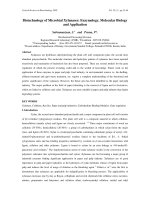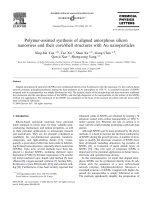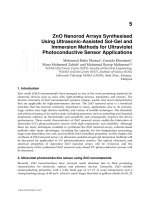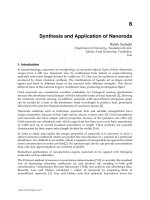Well defined silica polymer core shell hybrids and polymer hollow structures synthesis, characterization and application
Bạn đang xem bản rút gọn của tài liệu. Xem và tải ngay bản đầy đủ của tài liệu tại đây (13.62 MB, 237 trang )
WELL-DEFINED SILICA-POLYMER CORE-SHELL HYBRIDS
AND POLYMER HOLLOW STRUCTURES: SYNTHESIS,
CHRACTERIZATION AND APPLICATIONS
LI GUOLIANG
NATIONAL UNIVERSITY OF SINGAPORE
2011
WELL-DEFINED SILICA-POLYMER CORE-SHELL HYBRIDS
AND POLYMER HOLLOW STRUCTURES: SYNTHESIS,
CHRACTERIZATION AND APPLICATIONS
LI GUOLIANG
M. Sci., Polymer Chemistry and Physics
Nankai University 2007
B. Eng., Polymer Science and Engineering
Qingdao University of Science and Technology 2004
A THESIS SUBMITTED FOR
THE DEGREE OF DOCTOR OF PHILOSOPHY
DEPARTMENT OF CHEMICAL AND BIOMOLECULAR ENGINEERING
NATIONAL UNIVERSITY OF SINGAPORE
2011
I
ACKNOWLEDGEMENTS
There are many people that deserve thanks for their friendship, advice and support
during my time at NUS. I feel that I am very fortunate to be surrounded by so many
wonderful and helpful people. Without each of you I would not have been able to
accomplish the work described here.
First of all, I would like to thank my supervisor, Professor Kang En-Tang, for his
guidance to complete my Ph.D. study and thesis work. I am very grateful for his
patience and knowledgeable advice. I will forever treasure the friendship built up from
our supervisor-student relationship during my study at NUS.
Secondly, I would like to thank Prof. Neoh Koon-Gee, Prof. Wang Chi-Hwa for
advices and allowing their students collaborating with me, Prof. Srinivasan Madapusi P.
and Prof. Lanry Yung Linyue giving me some valuable suggestions and comments
during my Oral Qualifying Exam (O-QE) presentation.
Furthermore, I thank my collaborators Dr. Liu Gang, Ms Lei Chenlu, Dr. Wang Liang,
Dr. Zong Baoyu, and Mr. Liqun Xu, without whom my research cannot be shine
enough to get good publications. Further thanks to my 10 FYP (final year project)
students, Ms Liu Peilin, Ms Zeng Liming Dawn, Mr. Harjono Sutanto, Ms Tan Yee
Ling, Mr. Eng Zhong Sheng Edmund, Mr. Tai Chin An, Ms Shang Ying, Ms Ng Yen
Ling Joyce, Ms Yap Joleen, Ms Jiang Haipan. Further thanks to my colleagues Mr.
II
Zhao Junpeng, Mr. Li Min and Ms Wan Dong, instrument operator Dr. Yuan Zeliang,
Mr. Chia, Phai Ann and Mr. Mao Ning, lab officer Xu Yanfang and Alistair, and
administrative officer Doris How Yokeleng.
I would like to thank the National University of Singapore for proving financial
support through my period of candidate.
Finally, but not least, I would like to give my special appreciation to my wife Duan
Jingjing, who walked along with me during my stay at NUS, and my parents for their
support.
III
TABLE OF CONTENTS
ACKNOWLEDGEMENTS I
SUMMARY VII
NOMENCLATURE IX
LIST OF FIGURES X
LIST OF SCHEMES XVII
LIST OF TABLES XVIII
Chapter 1 Introduction 1
Chapter 2 Literature Review 5
2.1 Hollow Polymer Micro- or Nanostructures 6
Suspension Polymerization 7
Emulsion Polymerization 8
Dendrimers 11
Self-assembly 12
Core-shell Precursors 14
2.2 Precipitation Polymerization and Distillation-precipitation Polymerization 18
2.3 Sol-gel Process 23
2.4 Click Chemistry 25
Chapter 3 Stimuli-responsive Polymeric Hollow Microspheres from Silica/Polymer
Core-shell and Alternating Microspheres 28
3.1 Introduction 29
3.2 pH-Responsive Hollow Polymeric Microspheres and Concentric Hollow
IV
Silica Microspheres from Silica-Polymer Core-Shell Microspheres 32
3.2.1 Experimental Section 32
3.2.2 Results and Discussion 37
3.3 Alternating Silica/Polymer Multilayer Hybrid Microspheres Templates for
Double-shelled Polymer and Inorganic Hollow Microstructures 47
3.3.1 Experimental Section 47
3.3.2 Results and Discussion 52
3.4 Narrowly Dispersed Double-walled Concentric Hollow Polymeric
Microspheres with Independent pH and Temperature Sensitivity 65
3.4.1 Experimental Section 65
3.4.2 Results and Discussion 69
3.5 Conclusions 77
Chapter 4 Rattle-type Hollow Hybrid Microspheres 79
4.1 Introduction 80
4.2 Rattle-type Hollow Nanospheres of Mesoporous Silica Shell-Titania Core 82
4.2.1 Experimental Section 82
4.2.2 Results and Discussion 86
4.3 Hybrid Nanorattles of Metal Core and Stimuli-Responsive Polymer Shell for
Confined Catalytic Reactions 94
4.3.1 Experimental Section 94
4.3.2 Results and Discussion 98
4.4 Conclusions 111
Chapter 5 Hairy Particle Surfaces by Living Radical Polymerization and Click
Chemistry 113
V
5.1 Introduction 114
5.2 Hairy Hybrid Nanoparticles of Magnetic Core, Fluorescent Silica Shell and
Functional Polymer Brushes 118
5.2.1 Experimental Section 118
5.2.2 Results and Discussion 122
5.3 Hairy Hollow Microspheres of Fluorescent Shell and Temperature-Responsive
Brushes via Combined Distillation-Precipitation Polymerization and Thiol-ene
Click Chemistry 129
5.3.1 Experimental Section 129
5.3.2 Results and Discussion 133
5.4 Binary Polymer Brushes on Silica@Polymer Hybrid Nanospheres and Hollow
Polymer Nanospheres by Combined Alkyne-Azide and Thiol-Ene Surface Click
Reactions 146
5.4.1 Experimental Section 146
5.4.2 Results and Discussion 152
5.5 Hairy Hybrid Microrattles of Metal Nanocore with Functional Polymer Shell
and Brushes 162
5.5.1 Experimental Section 162
5.5.2 Results and Discussion 168
5.6 Hairy Polymer Hollow Nanospheres of Clickable and Bioactive Surface:
Synthesis, Characterization and Applications in Imaging and Drug Delivery 178
5.6.1 Experimental Section 178
5.6.2 Results and Discussion 186
5.7 Conclusions 198
Chapter 6 Conclusions and Recommendations for Future Work 200
VI
REFERENCES 205
LIST OF PUBLICATIONS 216
VII
SUMMARY
Well-defined inorganic/polymer core-shell hybrids and polymer hollow
micro-/nanostructures are of great interest because of their diverse applications in
chemistry, materials, biomedicine and nanotechnology. The aim of this work was to
develop a simple and general approach to the fabrication of functional
inorganic/polymer core-shell hybrids and polymer hollow nanostructures with unique
morphology and decorated surface functions via a combination of traditional
techniques, such as sol-gel chemistry, distillation-precipitation polymerization and
living radical polymerization with the newly developed ‘click’ chemistry. The
as-prepared polymer hollow micro-/nanospheres (single shell, double shell, rattle-type
and hairy hollow particles) could further been explored as drug delivery vehicles in
drug delivery systems (DDSs) and nanoreactors in confined catalytic reactions.
First of all, narrowly-distributed (or monodispersed) poly(methacrylic acid) (PMAA)
hollow microspheres with stimuli-responsive properties have been fabricated from the
corresponding silica/polymer composite hybrids via a combined
distillation-precipitation polymerization and sol-gel chemistry. By such means, hybrid
microsphres with alternating SiO
2
/PMAA layer were further produced by sol-gel
process and distillation-precipitation polymerization. Hollow PMAA microspheres
with double-shell structures and PMAA-PNIPAM double shelled hollow microspheres
were obtained by selective removal of silica core and inter-layer from the alternating
SiO
2
/PMAA/SiO
2
/PMAA hybrids in HF solutions. The obtained double-shelled PMAA
VIII
and PMAA-PNIPAM hollow particles could exhibit a reversible volume change to the
stimuli of the environmental medium
Subsequently, a serial of rattle-type hollow nanospheres with a polymer shell or
mesoporous silica shell and various metal nanocore (gold, silver, or anatase titania)
were synthesized using the metal/silica core-shell particles as templates. These
well-defined rattle hollow hybrid nanospheres, comprising of the two nanostructured
functional materials, can be used for confined catalytic reactions as a nanoreactor
system. Furthermore, the as-synthesized Ag@air@PMAA hybrid nanorattles with a Ag
nanocore, PMAA shell and free space in between. The as-synthesized
Ag@air@PMAA hybrid nanorattles were explored as a nanoreactor system for
confined catalytic reduction of 4-nitrophenol. The rate of catalytic reaction can be
further regulated by controlling molecule diffusion in and out of the stimuli-responsive
PMAA shell through the simple variation of environmental stimuli, such as salt (NaCl)
concentration of the medium.
Lastly, combination of the robust alkyne-azide, thiol-ene ‘click’ chemistry with the
living radical polymerization technique has been explored and exhibited a novel
strategy for the fabrication of polymer brush-decorated inorganic/polymer core-shell
hybrids and polymer hollow spheres. The as-prepared hollow nanospheres with hairy
surfaces and multiple functionalities could improve the particle properties and be
explored for biomedical applications as a probe for cell imaging and as a vehicle in
drug delivery systems (DDSs).
IX
NOMENCLATURE
AIBN 2,2’-Azobisisobutyronitrile
DDSs Drug delivery systems
DDW Doubly distilled water
DMF Dimethylformamide
DMP 2-Dodecylsulfanylthiocarbonylsulfanyl-2-methyl propionic acid
DVB Divinylbenzene
EGDMA Ethylene glycol dimethacrylate
HF Hydrofluoric acid
MAA Methacrylic acid
MPS 3-(trimethoxysilyl)propylmethacrylate
NIPAM N-isopropylacrylamide
PMA Propargyl methacrylate
PMDETA N,N,N’,N’,N´-pentamethyldiethylenetriamine
TBOT Titanium tetrabutoxide
TEOS Tetraethyl orthosilicate
THF Tetrahydrofuran
VCz N-vinylcarbazole
LRP Living radical polymerization
ATRP Atom transfer radical polymerization
RAFT Reversible addition-fragmentation chain transfer polymerization
X
LIST OF FIGURES
Figure 2.1 SEM micrographs of PDVB 55 microspheres by precipitation
polymerization (2 vol% of DVB 55 in acetonitrile).
Figure 2.2 SEM micrographs of the PDVB 80 microspheres by
distillation-precipitation polymerization.
Figure 3.1 FESEM and TEM micrographs of (a) and (b) 3-(trimethoxysilyl)
propylmethacrylate-silica (SiO
2
-MPS) seeds, (c) and (d) SiO
2
-PMAA core-shell
microspheres, and (e) and (f) SiO
2
-PMAA-SiO
2
tri-layer hybrid microspheres.
Figure 3.2 FT-IR spectra: (a) 3-(trimethoxysilyl) propylmethacrylate-silica (SiO
2
-MPS)
seeds, (b) SiO
2
-PMAA core-shell microspheres, (c) SiO
2
-PMAA-SiO
2
tri-layer hybrid
microspheres, (d) pH-responsive PMAA hollow microspheres, and (e) concentric
hollow silica microspheres.
Figure 3.3 XPS wide-scan spectra: (a) 3-(trimethoxysilyl) propylmethacrylate-silica
(SiO
2
-MPS) seeds, (b) SiO
2
-PMAA core-shell microspheres, (c) SiO
2
-PMAA-SiO
2
tri-layer hybrid microspheres, (d) pH-responsive PMAA hollow microspheres, and (e)
concentric hollow silica microspheres.
Figure 3.4 FESEM and TEM micrographs: (a) and (b) pH-responsive PMAA hollow
microsphere, and (c) and (d) concentric hollow silica microspheres.
Figure 3.5 EDX analysis spectra: (a) SiO
2
-PMAA core-shell microspheres, and (b)
pH-responsive hollow PMAA microspheres.
Figure 3.6 Hydrodynamic diameter (D
h
) of PMAA hollow microspheres as a function
of pH in the (a) absence and (b) presence of added NaCl to maintain a constant ionic
strength at 0.01M.
Figure 3.7 FT-IR spectra of the (a) SiO
2
/PMAA/SiO
2
tri-layer microspheres, (b)
SiO
2
/PMAA1/SiO
2
/PMAA2 tetra-layer microspheres.
Figure 3.8 TEM micrographs of the (a) SiO
2
/PMAA/SiO
2
tri-layer microspheres, (b)
SiO
2
/PMAA1/SiO
2
/PMAA2 tetra-layer microspheres.
Figure 3.9 FESEM and TEM micrographs of the (a) and (c) single-shelled PMAA1
hollow microspheres, (b) and (d) double-shelled PMAA1-PMAA2 hollow
microspheres. The inset in (b) is the TEM image of the SiO
2
/PMAA1/SiO
2
/PMAA2
tetra-layer microspheres.
XI
Figure 3.10 EDX spectra of (a) the SiO
2
/PMAA1/SiO
2
/PMAA2 tetra-layer hybrid
microspheres, and (b) the corresponding double-shelled PMAA1-PMAA2 hollow
microspheres.
Figure 3.11 Changes in relative hydrodynamic volume of the (a) single-shelled
PMAA1 hollow microspheres and (b) double-shelled PMAA1-PMAA2 hollow
microspheres as a function of pH.
Figure 3.12 (a) CLSM image of the double-shelled PMAA1-PMAA2 hollow
microspheres loaded with doxorubicin hydrochloride (DOX). (b) Release profiles of
DOX from single-shelled PMAA1 hollow microspheres and asymmetric
double-shelled PMAA1-PMAA2 hollow microspheres.
Figure 3.13 FESEM images of hollow microspheres after loading and releasing of
doxorubicin hydrochloride (DOX): (a) single-shelled PMAA1 and (b) double-shelled
PMAA1-PMAA2.
Figure 3.14 TEM images of the SiO
2
/PMAA1/SiO
2
/PMAA2/SiO
2
penta-layer hybrid
microspheres with different outer SiO
2
shell thickness controlled by TEOS feed
concentration of (a) 0.025 M and (b) 0.04 M during the synthesis from the
SiO
2
/PMAA1/SiO
2
/PMAA2 tetra-layer microspheres. (c) The TEM image of an
enlarged SiO
2
/PMAA1/SiO
2
/PMAA2/SiO
2
penta-layer microsphere from (b). (d) The
silica ‘core-double shell’ hollow microspheres after repeated calcination at 700
o
C for
3 h of the penta-layer microspheres in (b).
Figure 3.15 Field-emission TEM micrographs of the mesoporous structure of silica
outer shell in the concentric silica ‘core-double shell’ microspheres prepared via
repeated calcination at 550
o
C for 6 h.
Figure 3.16 Nitrogen adsorption-desorption isotherms and the corresponding pore size
distribution (inset) in the mesoporous silica outer shell of the concentric silica
‘core-double shell’ microspheres.
Figure 3.17 TEM and FESEM micrographs of (a) the SiO
2
/PMAA/SiO
2
tri-layer
microspheres with the polymerization time of the outer layer fixed at 24 h, (b) and (c)
the SiO
2
/PMAA/SiO
2
/PNIPAM tetra-layer microspheres, and the PMAA-PNIPAM
double-walled concentric hollow microspheres (d) before and (e) after exposure to an
aqueous medium of pH=10 and 25
o
C and (f) pH=4 and 25
o
C.
Figure3.18 FT-IR spectra of (a) the SiO
2
/PMAA/SiO
2
tri-layer microspheres, (b) the
SiO
2
/PMAA/SiO
2
/PNIPAM tetra-layer microspheres, and (c) the PMAA-PNIPAM
double-walled concentric hollow microspheres.
XII
Figure 3.19 Hydrodynamic diameters (D
h
) of the double-walled PMAA-PNIPAM
concentric hollow microspheres and their size distribution in aqueous media of 25
o
C
and 40
o
C at a constant pH of 10.
Figure 3.20 (a) CLSM image of the double-walled PMAA-PNIPAM concentric
hollow microspheres with loaded with DOX, and (b) DOX release profiles of the
double-walled PMAA-PNIPAM concentric hollow microspheres.
Figure 4.1 FESEM and TEM micrographs of the (a) PMAA template cores, (b)
PMAA/TiO
2
@PMAA core-shell nanospheres, (c) PMAA/TiO
2
@PMAA@SiO
2
trilayer
hybrid nanospheres, (d) hollow silica nanospheres with an inner titania core after
removal of the polymeric templates, (e) mesoporous silica shell under higher
magnification, and (f) hollow core-shell nanostructures containing multiple titania
cores.
Figure 4.2 XPS wide-scan spectra of the (a) PMAA template cores, and (b)
PMAA/TiO
2
composite nanoparticles.
Figure 4.3 XRD spectrum and TEM image of of the mosoporous anatase TiO
2
nanocores obtained from calcination of the PMAA/TiO
2
composite nanospheres at
550
o
C for 6 h using the PMAA of 236 nm in diameter as templates.
Figure 4.4 FT-IR spectra of (a) the PMAA/TiO
2
@PMAA@SiO
2
trilayer hybrid and (b)
the corresponding concentric hollow titania core-silica shell nanospheres.
Figure 4.5 Nitrogen adsorption-desorption isotherms and the corresponding pore size
distribution plot (inset) of the concentric hollow nanospheres with a mesoporous silica
shell.
Figure 4.6 (a) Concentric hollow nanospheres of mesoporous silica shell-titania core
as reaction cages for photocatalysis, and (b) the rate of TiO
2
-catalysed
photodegradation of methyl orange in the concentric hollow silica cages. (k
a
is the
apparent first-order rate constant.)
Figure 4.7 TEM micrograph of the silver nanocore.
Figure 4.8 TEM micrographs of the (b) Ag@SiO
2
core-shell NPs with different silica
shell thickness: (a) and (a’) 8 nm, (b) and (b’) 15 nm, (c) and (c’) 53 nm.
Figure 4.9 FT-IR spectra of the (a) Ag@SiO
2
core-shell-3 and (b) Ag@SiO
2
@PMAA
core-double shell-2 NPs.
Figure 4.10 TEM micrographs of the Ag@SiO
2
@PMAA core-double shell NPs with
XIII
different PMAA outer shell thickness: (a) 27 nm, (b) 42 nm and (c) and (d) 67 nm.
Figure 4.11 TEM micrographs of the Ag@air@PMAA hybrid nanorattles with
different PMAA shell thickness: (a) and (a’) 27 nm, (b) and (b’) 42 nm, (c) and (c’) 67
nm.
Figure 4.12 UV-visible absorption spectra of (a) Ag nanocores, (b) Ag@SiO
2
core-shell NPs and (c) Ag@air@PMAA hybrid nanorattles in aqueous dispersions.
Figure 4.13 (a) Catalytic reduction of p-nitrophenol (C
0
= 3.4 x 10
-4
M) by the Ag NPs
(~1.2 x 10
-3
M) as monitored by time-dependent UV-visable absorption. (b) Reaction
kinetics of p-nitrophenol reduction by the Ag NPs under the effect of salt
concentration of the medium (pH 9.2, C
0
and C
t
are the initially and instantaneous
concentration of p-nitrophenol, respectively).
Figure 4.14 (a) Catalytic reduction of p-nitrophenol (C
0
= 3.4 x 10
-4
M) by the
Ag@air@PMAA nanorattles (from Ag@SiO
2
@PMAA core-double shell-3 NPs in
Table 3.2, ~1.2 x 10
-3
M with respect to the Ag concentration, PMAA shell thickness
= 67 nm)) as monitored by time-dependent UV-visable absorption. (b) Reaction
kinetics of p-nitrophenol reduction by the Ag@air@PMAA nanorattles under the
effect of salt concentration of the medium (pH 9.2, C
0
and C
t
are the initially and
instantaneous concentration of p-nitrophenol, respectively).
Figure 5.1 TEM (a, c, e, f) and AFM (b and d) micrographs of the (a) and (b)
Fe
3
O
4
/DySiO
2
nanoparticles, (c) and (d) Fe
3
O
4
/DySiO
2
-g-P(PEGMA) nanoparticles,
and (e) and (f) Fe
3
O
4
/DySiO
2
-PMAA nanoparticles.
Figure 5.2 FT-IR spectra of the (a) Fe
3
O
4
/DySiO
2
-MPS, (b) Fe
3
O
4
/DySiO
2
-PVBC, (c)
Fe
3
O
4
/DySiO
2
-g-P(PEGMA) and (d) Fe
3
O
4
/DySiO
2
-g-PS nanoparticles.
Figure 5.3 XPS wide-scan spectra of (a) the Fe
3
O
4
/DySiO
2
nanoparticles and (b) the
Fe
3
O
4
/DySiO
2
-PVBC nanoparticles; (c) C 1s and (d) Cl 2p core-level spectra of the
Fe
3
O
4
/DySiO
2
-PVBC nanoparticles; wide-scan and C 1s core-level spectra of (e) and
(f) the Fe
3
O
4
/DySiO
2
-g-P(PEGMA) nanoparticles, and (g) and (f) the
Fe
3
O
4
/DySiO
2
-g-PS nanoparticles.
Figure 5.4 (a) FESEM and (b) TEM images of the SiO
2
-MPS seed microspheres
prepared by sol-gel process; TEM images of the (c) SiO
2
@PVK Core-shell-1 and (d)
SiO
2
@PVK Core-shell-2 microspheres of Table 4.1 prepared by
distillation-precipitation polymerization.
Figure 5.5 FT-IR spectra of the (a) SiO
2
-MPS seed microspheres, (b) SiO
2
@PVK
Core-shell-2 microspheres, and (c) SiO
2
@PVK-PNIPAM hairy core-shell
microspheres.
XIV
Figure 5.6 XPS wide-scan spectra of the (a) SiO
2
-MPS seed microspheres, (b)
SiO
2
@PVK Core-shell-2 microspheres, (c) SiO
2
@PVK-PNIPAM hairy core-shell
microspheres, and (d) air@PVK-PNIPAM hairy hollow microspheres.
Figure 5.7 UV-visible absorption spectra of the (a) SiO
2
-MPS seed microspheres, (b)
SiO
2
@PVK Core-shell-2 microspheres and (c) SiO
2
@PVK-PNIPAM hairy core-shell
microspheres.
Figure 5.8 Fluorescence spectra of the (a) SiO
2
@PVK Core-shell-2 microspheres and
(b) SiO
2
@PVK-PNIPAM hairy core-shell microspheres (λ
Ex
= 295 nm).
Figure 5.9 FESEM and TEM images of the (a) and (b) SiO
2
@PVK-PNIPAM hairy
core-shell microspheres, (c) and (d) air@PVK-PNIPAM hairy hollow microspheres.
Figure 5.10 Thermo-gravimetric analysis (TGA) traces of the (a) SiO
2
@PVK
Core-shell-2 microspheres and (b) the corresponding SiO
2
@PVK-PNIPAM hairy
core-shell microspheres. TGA was performed in air at a heating rate of 20
o
C/min from
25 to 800
o
C.
Figure 5.11 EDX analysis spectra of the (a) SiO
2
@PVK-PNIPAM hairy core-shell
microspheres, and (b) air@PVK-PNIPAM hairy hollow microspheres.
Figure 5.12 Hydrodynamic diameters (D
h
) of the air@PVK-PNIPAM hairy hollow
microspheres in the aqueous medium at two different temperature of 25 and 50
o
C.
Figure 5.13 (a) FESEM and (b) TEM images of the air@PVK-PNIPAM hairy hollow
microspheres, after explosure to acid (HCl, pH 2) for 24 h, base solution (NaOH, pH
12) for 24 h and high centrifugation force (10,000 rpm)
Figure 5.14 Transmission electron microscopy (TEM) micrographs and field-effect
scanning electron microscopy (FESEM) micrographs of the (a) and (a’) SiO
2
, (b) and
(b’) SiO
2
@P(MAA-co-PMA-co-DVB) and (c) and (c’)
SiO
2
@P(MAA-co-PMA-co-DVB)-click-PS/PEG nanospheres.
Figure 5.15
1
H NMR spectra of polystyrene (PS) prepared from atom transfer radical
polymerization before and after end-group transformation: (bottom) alkyl
halide-terminated PS-Br and (top) azido-terminiated PS-N
3
chains.
Figure 5.16 Gel permeation chromatography (GPC) elution curve of azido-terminiated
polystyrene (PS-N
3
) chains in tetrahydrofuran (THF) at an elution rate of 1.0 mL
min
−1
.
Figure 5.17 X-ray photoelectron spectroscopy (XPS) analysis of the (a)
XV
SiO
2
@P(MAA-co-PMA-co-DVB), (b,c) SiO
2
@P(MAA-co-PMA-co-DVB)-click-PS,
and (d) SiO
2
@P(MAA-co-PMA-co-DVB)-click-PS/PEG nanospheres.
Figure 5.18 Thermogravimetric analysis (TGA) of the (a) SiO
2
, (b)
SiO
2
@P(MAA-co-PMA-co-DVB), (c) SiO
2
@P(MAA-co-PMA-co-DVB)-click-PS and
(d) SiO
2
@P(MAA-co-PMA-co-DVB)-click-PS/PEG nanospheres.
Figure 5.19 (a) Field-effect scanning electron microscopy (FESEM) and (b) TEM
micrographs of the air@P(MAA-co-PMA-co-DVB)-click-PS/PEG hairy hollow
nanospheres.
Figure 5.20 Energy dispersive X-ray (EDX) analysis spectra of the (a)
SiO
2
@P(MAA-co-PMA-co-DVB)-click-PS/PEG nanospheres and (b)
air@P(MAA-co-PMA-co-DVB)-click-PS/PEG hollow nanospheres.
Figure 5.21 TEM and FESEM micrographs of the (a) 18 nm gold (Au) nanocores, (b)
135 nm Au@SiO
2
-MPS, and (c) 196 nm Au@SiO
2
-MPS core-shell microspheres, (d)
308 nm Au@SiO
2
@P(MAA-co-DVB) core-double shell microspheres, and (e) and (f)
Ag@air@P(MAA-co-DVB)-click-PNIPAM hybrid microrattles.
Figure 5.22 XPS wide-scan and C 1s core-level spectra of the (a and b)
Au@SiO
2
@P(MAA-co-DVB), and (c and d)
Au@SiO
2
@P(MAA-co-DVB)-click-PEG.
Figure 5.23 Catalytic reduction of p-nitrophenol in the cavity of
Au@air@P(MAA-co-DVB)-click-PEG hybrid microrattles (C
0
and C
t
are the initial
and instantaneous concentrations of p-nitrophenol, respectively, C
0
= 8.5 x 10
-5
M).
The inset is the TEM image of the synthesized hybrid microrattle with a gold nanocore
(18 nm in diameter) and PEG brushes (M
n
= 5,000 g/mol) on the exterior surfaces.
Figure 5.24 TEM micrographs for the (a) MPS-modified silica (SiO
2
-MPS) template
and (b) SiO
2
@P(MAA-co-DVB-co-VBC) core-shell hybrid nanospheres.
Figure 5.25 XPS (a) wide-scan, (b) Cl 2p and (c) C 1s core-level spectra of the
SiO
2
@P(MAA-co-DVB-co-VBC) core-shell hybrid nanospheres.
Figure 5.26 FT-IR spectra of the (a) SiO
2
@P(MAA-co-DVB-co-VBC),
(b) SiO
2
@P(MAA-co-DVB-co-VBC-N
3
)-click-PEG and (c)
SiO
2
@P(MAA-co-DVB-co-VBC)-click-PEG/FD nanospheres.
Figure 5.27 TGA curves of the SiO
2
@P(MAA-co-DVB-co-VBC) core-shell hybrid
microspheres (a) before and (b) after click grafting of the PEG brushes on the exterior
surface via thiol-ene click reaction.
XVI
Figure 5.28 Fluorescent spectra of the
(a) SiO
2
@P(MAA-co-DVB-co-VBC-N
3
)-click-PEG, (b)
SiO
2
@P(MAA-co-DVB-co-VBC)-click-PEG/FD, and (c)
air@P(MAA-co-DVB-co-VBC)-click-PEG/FD hollow nanospheres.
Figure 5.29 FESEM and TEM micrographs of the hairy
air@P(MAA-co-DVB-co-VBC)-click-PEG/FD hollow nanospheres with
biocompatible and fluorescent properties.
Figure 5.30 Viability of the NIH3T3 fibroblast incubated in a growth medium
containing 200µg/mL of the air@P(MAA-co-DVB-co-VBC)-click-PEG/FD hollow
nanospheres for a period of up to 48 h. The absorbance value is proportional to the
number of viable cells, therefore indicates the cell viability. Each data point represents
mean ± SD, n=6. * denotes statistical differences (p < 0.05) compared to the control
group.
Figure 5.31 Confocal laser scanning microscopy (CLSM) of C6 glioma cells after (a)
2 h, (b) 6 h of incubation with the air@P(MAA-co-DVB-co-VBC)-click-PEG/FD
hollow nanospheres at a concentration of 200 µg/mL. Images were obtained from
upper left: FITC channel (Excitation at 488 nm), upper right: TRIC channel (Excitation
at 543 nm), lower left: Differential interference contrast (DIC) channel, lower right:
overlapped FITC, TRIC and DIC channel.
Figure 5.32 In vitro viability of C6 glioma cells after 24 and 48 h of incubation with
pure doxorubicin or doxorubicin-loaded nanospheres at equivalent drug concentration
of 0.01, 0.1, 1, 10 µg/mL at 37°C. Each data point represents mean ± SD, n=6. *
denotes statistical differences (p < 0.05), and ** denotes statistical differences (p <
0.01), compared to the control group.
XVII
LIST OF SCHEMES
Scheme 2.1 Synthesis of hollow polymer particles from template-directed core-shells
precursors.
Scheme 2.2 Alkyne-azide and thiol-ene click reactions.
Scheme 3.1 Schematic illustration of the preparation of pH-responsive PMAA hollow
microspheres and concentric hollow silica microspheres.
Scheme 3.2 Schematic illustration of the synthesis of PMAA1-PMAA2 hollow
microspheres with pH-responsive asymmetric double shells and silica ‘core-double
shell’ hollow microspheres.
Scheme 3.3 Schematic illustration of the preparation of polymer/silica alternating
hybrid microspheres and double-walled concentric hollow polymeric microspheres
with independent sensitivity to pH and temperature.
Scheme 4.1 Combined polymerization and sol-gel reactions for the preparation of
nearly monodispersed concentric hollow nanospheres composed of mesoporous silica
shells and anatase titania inner cores.
Scheme 4.2 Schematic illustration of the synthesis of Ag@SiO
2
@PMAA core-double
shell and Ag@air@PMAA rattle-type hybrid NPs.
Scheme 4.3 The Ag@air@PMAA hybrid nanorattle as a nanoreactor for the confined
catalytic reduction of p-nitrophenol by NaBH
4
.
Scheme 5.1 Synthesis of the hairy hybrid nanoparticles with a magnetic core,
fluorescent silica shell and functional polymer brushes.
Scheme 5.2 Schematic illustration of the fabrication of air@PVK-PNIPAM hairy
hollow microspheres by combined sol-gel reaction, distillation-precipitation
polymerization and thiol-ene click chemistry.
Scheme 5.3 Schematic illustration of the synthesis of binary polymer brushes on the
silica@copolymer core-shell hybrid nanosphere surface via the alkyne-azide and
thiol-ene dual click reactions.
Scheme 5.4 Schematic illustration of the synthesis of hairy metal@air@polymer
hybrid microrattles with a metal nanocore, a cross-linked polymer shell and functional
polymers brushes on the exterior surface.
Scheme 5.5 Schematic illustration of the synthesis of biocompatible and fluorescent
polymer hollow nanospheres via combination of dual ‘click’ reactions (alkyne-azide
and thiol-ene reactions) with sol-gel reaction and distillation-precipitation
polymerization.
XVIII
LIST OF TABLES
Table 2.1 Overview of methods for the preparation of hollow polymer particles.
Table 3.1 Comparison of the DOX release rates from the single and double-shelled
PMAA hollow microspheres.
Table 4.1 Size and size distribution of the multilayer hybrid nanospheres and
concentric hollow nanospheres of mesoporous silica shell-titania core.
Table 4.2 Size, size distribution and shell thickness of the hybrid nanoparticles.
Table 5.1 Size, size distribution and shell thickness of the SiO
2
@PVK core-shell
microspheres.
Table 5.2 Size, size distribution and shell thickness of the SiO
2
@polymer nanospheres
with surface grafted binary brushes.
Table 5.3 Size, size distribution and shell thickness of the metal@silica core-shell and
metal@silica@polymer core-double shell microspheres.
1
Chapter 1 Introduction
2
In the past decade, hollow polymeric micro- and nanostructures have attracted
considerable interest because of their new functionalities and unique physicochemical
properties.
1-6
The development of hollow polymer structure is reflected by the rapid
increase in the number of scientific publications and patents in recent years.
3, 7-8
Hollow polymer structures are potentially useful as encapsulates for drugs,
enzymes,
protein, genes and catalysts, as transducers and dielectrics for electronics, as absorbent
materials for sound and microwave, as contrast agents for diagnostics, as nanoreactors
for the fabrication of devices, and as label-free chip sensor.
9-12
Hollow particles with
various polymeric materials have been developed via various polymerization
techniques. Sol-gel reaction and distillation-precipitation polymerization as the robust
approaches have been developed for the fabrication of inorganic nanoparticles and
polymer microspheres respectively. The new developed living radical polymerization
(LRP) and ‘click’ chemistry have greatly facilitated the progress in polymer chemistry
and material science. A combination these techniques together for construction of new
hollow micro-/nanostructure will be of great interest. For improvement in treatment of
numerous diseases, the design and synthesis of more sophisticated microstructures and
materials with novel molecular architecture for specific applications is an on-going
effort.
Despite of the diverse methods to fabrication of hollow structures have been reported
for their potential applications in biomedicine, catalysis and paints, and as electronics
materials. In these applications, most of the shell materials are inorganic or ceramic
3
shell or only un-functional polymer shells. However, there are still limited reports on
the fabrication of hollow structure with polymer shells and functional groups on the
shell, which is probably due to the complexity in synthesis procedures and difficulty in
selective functionalization of the shell materials. The overall purpose of this thesis is to
synthesize hollow polymer micro- and nanospheres with novel morphology and
functions via a combination of inorganic and polymer synthesis and optimize the
applications of these hollow polymer structures in drug delivery and confined catalytic
reactions. This research focuses on controlling the size, size distribution and novel
morphology of the polymer structures. The objective of this thesis was also to
endowing hollow polymer shells with functional properties via grafting of
environmental-stimuli responsive polymers. In response to external stimuli, such as
temperature, pH, ionic strength, electric field and magnetic flux, the smart hollow
particles can undergo reversible structural transition and self-adjustment of their
physicochemical properties.
The thesis consists of six chapters. Chapter 2 gives overview of the related literatures.
This chapter starts with a brief introduction of the polymer hollow structures by
various approaches. Subsequently, the approaches used in our thesis work such as
distillation-precipitation polymerization, sol-gel process, alkyne-azide and thiol-ene
‘click’ reactions are introduced. In chapter 3, alternating silica/PMAA and
silica/PNIPAM multilayer hybrid microspheres is constructed by combined sol-gel
process and distillation precipitation polymerization. Selective removal of silica core
4
or layers from these alternating hybrids gives rise to pH-responsive poly(methacrylic
acid) (PMAA) microspheres, hierarchical pH-responsive double-shelled PMAA hollow
microspheres, and dually responsive (pH- and termperature- double-shelled
PMAA/PNIPAM hollow microspheres. In Chapter 4, novel rattle-type hollow
microspheres are prepared through a combined sol-gel reaction and distillation
precipitation polymerization The as-prepared SiO
2
/TiO
2
rattles consists of two
inorganic materials of a mesoporous silica and anatase titania dioxide. The as-prepared
Ag/PMAA hybrid rattles consists of a pH-responsive PMAA shell and catalytic silver
metal core. These novel rattles can be explored as a nanoreacter system in a confined
space between the hollow shell and core. In chapter 5, a series of well-defined hairy
core-shell and hairy hollow nanostructures were prepared by incorporation of
alkyne-azide and thiol-ene surface ‘click’ reactions to surface modify silica/polymer
core-shell microspheres, such as hairy hollow polymer microspheres with a flurescent
poly(N-vinylcarbazole) (PVK) shell and temperature-responsive
poly(N-isopropylacrylamide) (PNIPAM) brushes; polymer hollow microspheres with
binary brushes (hydrophobic polystyrene and hydrophilic polyethylene glycol); hairy
rattle-type hybrid microspheres consisting of a metal nanocore (gold or silver), a
poly(mathacrylic acid-co-divinylbenzene) (P(MAA-co-DVB)) shell, and functional
polymer brushes clicked on the exterior surface; pH-responsive, biocompatible and
fluorescent multifunctional polymer hollow nanospheres for bi-modal biomedical
applications as an imaging probe and a drug delivery vehicle. Finally, conclusions of
the work and recommendations for future work are presented in chapter 6.
5
Chapter 2 Literature Review









